


[British Museum Catalogue of Greek Coins, Central Greece—by B. V. Head, 1884.
E. Curtius, Hermes, vol. x, 1876, p. 215 sqq.
Imhoof-Blumer, Monatsbericht d. k. Akad. d. Wissensch., Berlin 1881.
Dondorff, De rebus Chalcidensium, Halle 1855.
Heinze, De rebus Eretriensium Göttingen 1869.]
That an island of the extent and importance of Euboea should have had no native currency during the period of her greatest colonizing and commercial activity is a proposition hardly to be entertained. Chalcis and Eretria, from the dawn of history down to the close of the sixth century, were the two most enterprising cities in European Greece, as is shown by the large number of Chalcidian and Eretrian colonies on the coasts of Thrace, of Southern Italy, and of Sicily.
Euboea, also, in very early times had already given her name to one of the most widely used standards for weighing the precious metals; a remarkable fact, and one which is alone sufficient to warrant us in supposing that Euboea would be one of the starting-points of the art of coining on the western side of the Aegean Sea. Granting therefore that, in all probability, coins must have been issued in Euboea during the period of her colonizing activity (and especially during and after the Lelantine war, when the rival Euboean cities Chalcis and Eretria fought out their quarrel for maritime supremacy, a struggle in which all the more important states, e.g. Corinth, Corcyra, Samos, Miletus, &c., took part), we must seek for them among the archaic and uninscribed specimens of the Euboïc standard.
It cannot, however, be denied that among the numerous archaic and anepigraphic silver coins of Euboïc weight and of various types it is a matter of conjecture which belong to the Euboean towns, Chalcis, Eretria, Cyme, &c., and which are contemporary issues of other states in intimate commercial relations with Euboea. All these coins nevertheless form a class distinguishable from the contemporary issues of Aegina and from those of most of the Aegaean islands, not only by their weight but also by their incuse squares divided diagonally instead of rectangularly or otherwise. Most of these uncertain archaic coins of the Euboïc standard are also characterized by what seems to be a local peculiarity, the plain linear circle which encloses their obverse types. This is an indication that they were struck at closely connected mints, if not at a single mint on behalf of various towns. Linear circles do not
Most of the coins of the above-mentioned series were formerly assigned
to Athens before the time of Pisistratus, on the ground that they have
been usually discovered in Attica; but as some of them are distinctly
later in style than the earliest Athenian tetradrachms, it may be con-
fidently asserted that Athens could not have issued from her single mint
so many various series of coins simultaneously with her own well-known
‘Owls’. The circumstance that they are usually found in Attica [1] is
easily explained by the close relations which always existed between
Attica and Euboea, and by the identity of standard (135 and 270 grs.
max.) which enabled them to circulate side by side with the money of
Athens. The uninscribed archaic coins of the Euboïc standard with
a diagonally divided incuse square bear on their obverses, usually within
a linear circle, the following types :—Owl; Horse walking; Hind part
of walking horse; Forepart of prancing horse; Amphora; Triskeles;
Astragalos; Wheel of peculiar form ![]() ; Wheel of four spokes Θ;
Scarabaeus; Gorgoneion; Bull’s head to front. On the evidence of
inscribed specimens of a somewhat later date (flatter fabric, and types
on both sides) the Wheel may be assigned to Chalcis and the Gorgoneion
and Bull’s head to Eretria. The attribution of the remaining types is
doubtful, though it is tempting to assign the Horse types to Cyme on the
ground that similar types are characteristic of its colony Cyme in Aeolis.
In Euboea, as elsewhere in Greece, the Persian Wars form the lower limit
of the early archaic coinage. The war over, the cities of Euboea were
enrolled among the allies of Athens, and such of them as retained the
right of coinage adopted a new and improved method of striking money,
and for the most part new types. The various Euboean cities to which
these and later coins may be attributed are the following:—
; Wheel of four spokes Θ;
Scarabaeus; Gorgoneion; Bull’s head to front. On the evidence of
inscribed specimens of a somewhat later date (flatter fabric, and types
on both sides) the Wheel may be assigned to Chalcis and the Gorgoneion
and Bull’s head to Eretria. The attribution of the remaining types is
doubtful, though it is tempting to assign the Horse types to Cyme on the
ground that similar types are characteristic of its colony Cyme in Aeolis.
In Euboea, as elsewhere in Greece, the Persian Wars form the lower limit
of the early archaic coinage. The war over, the cities of Euboea were
enrolled among the allies of Athens, and such of them as retained the
right of coinage adopted a new and improved method of striking money,
and for the most part new types. The various Euboean cities to which
these and later coins may be attributed are the following:—
Carystus. Of this town it does not appear that there are many coins of the sixth century, but after B.C. 480, except during the intervals of Athenian and Macedonian rule, the coinage is continuous.
| ΚΑRVΣΤΙΟ[Ν] Ox scratching itself with its horn. [Babelon, Traité, Pl. XXXII. 14.] | Incuse square, in which cock.
AR Tetradr.
|
| Cow suckling calf. [B. M. C., Cent. Gr., Pl. XVIII. 1, 5, 6, 11.] | Κ, ΚΑ, or ΚΑΡΥΣ, &c. Incuse square
(except on later coins), within which,
cock. AR Didr.
|
| Head of Herakles. [Ibid., Pl. XVIII. 3.] |
ΚΑΡΥ Bull recumbent.
AR Drachm, and ½ Drachm.
|
| Id. [Ibid., Pl. XVIII. 4.] | Κ Α Palm tree. ½ Dr.
|
| Forepart of bull. [Ibid., Pl. XVIII. 2.] | Incuse square, palm tree. AR ½ Drachm.
|
| Bull’s head. [Ibid., Pl. XVIII. 9.] | ΚΑΡΥ Two palm trees. AR Diobol.
|
| Bull’s head. [N. C., 1898, Pl. XIX. 7.] |
Palm tree in incuse square. AR Obol.
|
1 before the publication of the first edition of the present work there was, however, a find of these coins in the island of Euboea itself. U. Koehler, Münzfunde auf Euboea in the Mitth. d. Arch. Inst. Athen., ix. p. 354.
| Head of Apollo. [B. M. C., Cent. Gr., Pl. XVIII. 10.] |
Κ Three palm trees. AR Obol.
|
| Head of Herakles. [Ibid., Pl. XVIII. 13.] |
ΚΑ Bull’s head. Æ .7
|
| Head of bearded Herakles. [B. M. Guide, Pl. XLIII. 29.] |
ΚΑΡΥ Bull recumbent. AV 49.3 grs.
|
| Beardless head, bound with royal dia- dem. [1] [B. M. Guide, Pl. XLIII. 30.] | ΚΑΡΥΣΤΙΩΝ Nike in biga. AR Didr.
|
| Head of bearded Herakles. [N. C., 1890, Pl. XIX. 9.] |
ΚΑΡΥ and magistrate’s name ΦΙΛΩΝ.
Bull rushing; beneath, club.
AR Drachm, 64.2 grs.
|
| Head of Herakles. [B. M. C., Cent. Gr., Pl. XIX. 3.] |
ΚΑ Bull’s head. Æ .7
|
| Head of Zeus. [Ibid., Pl. XIX. 4.] | ΚΑΡΥΣΤΙΩΝ Eagle; wings open. Æ .7
|
| Veiled head of Hera. [Ibid., Pl. XIX. 5.] | ΚΑΡΥ Bull butting. Æ .65
|
| Id. [Ibid., Pl. XIX. 8.] | ΚΑΡΥ Dolphin. Æ .65
|
| Head of Poseidon. [Ibid., Pl. XIX. 6.] | ΚΑΡΥΣΤΙΩΝ Dolphin and trident.
Æ .7
|
| Head of young Dionysos (?). [Ibid., Pl. XIX. 9.] |
ΚΑΡΥ Dolphin. Æ .55
|
The Imperial coins (Nero and Trajan) have usually a head of Poseidon on the reverse. Sestini (Mus. Font., iii. Pl. IV. 18) attributes also a coin to M. Aurelius.
For the Cow and calf see Corcyra, p. 326. The Bull or Cow is possibly connected with the cult of Hera, who possessed a primitive temple on Mount Oche, at the foot of which Carystus stands (Steph. Byz. s.v. Καρυστος; Walpole, Travels, p. 235).
The Cock (κηρυξ, καρυξ, Aristoph. Eccl. 30) may perhaps contain an allusion to the name of the town Καρυστος, cf. καρυσσω (Anthol., p. 5. 3), to crow; see Himera, p. 144.
The gold coins of Carystus were called drachms; see the Inventory of Demares, one of the Ιεροποιοι of the Temple of Apollo at Delos, who, among other gold and silver coins dedicated to the god, registers 1 Carystian gold drachm (B. C. H., 1882, p. 49).
Chalcis. This important Ionic town, the mother-city of so many colonies in Italy, Sicily, and the peninsula of Chalcidice, carried on an extensive commerce in early times with all parts of the Hellenic world. Its relations with the Ionians of Asia Minor were probably instrumental in introducing into Europe the standard for weighing gold and silver, afterwards known as the Euboïc. The earliest Chalcidian coins may have been of electrum (wts. 45 and 22.5 grs.), but, in spite of their types, the provenance of these pieces points rather to Samos as their
1 The doubtful head on this coin has been thought by Gardner (N. C., 1878, p. 98) to be that of Antiochus III, and by J. P. Six (N. C., 1894, p. 299) to be that of Alexander, the son of Crateros, and nephew of Antigonus Gonatas, who appears to have been called King of Euboea, about B.C. 250. Although the portrait bears no special resemblance to those on any coins of Antiochus, there are objections, on various grounds, to so early a date as B.C. 250.
| Eagle devouring hare. [B. M. C., Cent. Gr., Pl. XX. 1.] |
Irregular incuse square. El. 44.4 grs.
|
| Eagle flying. [Ibid., Pl. XX. 2.] | Id. El. 22.1 grs.
|
| Wheel of four spokes. [Ibid., Pl. XX. 3.] |
Id. El. 21.8 grs.
|
The following archaic silver coins may, however, with much greater probability be attributed to Chalcis, though, as M. Svoronos has pointed out, those with the Wheel on the obv. might be assigned to Megara, as specimens have been found along the coasts of the Saronic Gulf (Journ. Int., i. 373 f.).
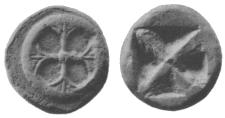
| Archaic wheel with transverse spokes. [Babelon, Traité, Pl. XXXIII. 14.] |
Incuse square diagonally divided.
AR Didr.
|
| Wheel of four spokes (Fig. 200). | Id. AR Didr.
|
| Id. [B. M. C., Cent. Gr., Pl. XX. 5.] | Id. AR Dr.
|
| Id. | Id. AR Trihemiobol.
|
| Id. | Id. AR Obol.
|
| Ψ (archaic Χ) on so-called Boeotian shield. | Wheel in incuse square. AR Tetradr.
[Imhoof, Mon. gr., p. 221.]
|
| Flying eagle r., holding serpent. [Green- well Colk, N. C., 1890, PI III. 23; [Z. f. N., xxi. Pl. V. 3.] | AR Tetradr. 260 grs.
|
| Similar, but eagle to l. [Z. f. N., xvii. Pl. I. 3.] |
Similar, but wheel in incuse triangle
instead of square. AR Tetradr.
|
| Flying eagle, holding serpent. | Wheel in incuse triangle. AR Didr.
[Zeit. f. Num., iii. p. 217.]
|
| Id. or without serpent. [B. M. C., Cent. Gr., Pl. XX. 8.] |
ΨΑ AR Tetrob.
|
| Eagle flying. | „ Id. AR Obol.
|
For similar coins see also Olynthus in Chalcidice (p. 208).
The conquest of Chalcis by the Athenians in B.C. 507 would seem to be the lower limit of its archaic coinage. Between this date and the time of Epaminondas, circ. B.C. 370, it can hardly have been in a position to strike coins in its own name.
| Female head with ear-ring. [B. M. C., Cent. Gr., Pl. XX. 9.] |
ΧΑΛ Flying eagle, holding serpent.
AR 58 grs.
|
| Id. [Ibid., Pl. XX. 12.] | „ Id. devouring hare. AR 27 grs.
|
| Female head with ear-ring. [Ibid., Pl. XX. 13.] |
Χ Α Eagle standing. AR Obol.
|
| Id. facing, wearing diadem surmounted by live disks, connected by a fillet. [Ibid., Pl. XX. 15.] | ΧΑΛ Id. devouring serpent. Æ .55
|
| Female head in profile, covered with head-dress of pearls. [Ibid., Pl. XX. 17.] | „ Id. Æ .65
|
The female head on these coins is probably the celestial Hera, a lunar goddess worshipped on Mount Dirphys, overlooking the Chalcidian plain. The disks which encircle the head may symbolize the Planets (cf. Over- beck, Kunst-Mythologie, iii; Gemmentafel, i. 8). The Eagle devouring a Serpent seems to be an emblem of the Olympian Zeus, as on the coins of Elis, for at Chalcis one of the chief shrines was that of Zeus Olympios (cf. Hicks, Gr. Hist. Inscr., 2nd ed., No. 40, p. 65).
Throughout the Macedonian period Chalcis was one of the chief strong- holds of the kings of Macedon, and was hence called one of the three fetters of Greece. Tetradrachms of Alexander’s types were struck there , symbol, Head of Hera encircled by disks as above. This type was some- times used as a countermark over bronze coins of Antigonus (N. C., 1898. Pl. XIX. 9).
In B.C. 197 Chalcis received her freedom at the hands of Flamininus, as did also the other Euboean towns Carystus, Eretria, and Histiaea.
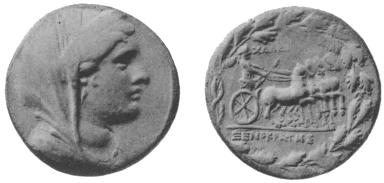
| Head of Hera veiled, and wearing stephane (Fig. 201). | ΧΑΛΚΙΔΕΩΝ Hera with sceptre in
quadriga. Magistrate’s name, ΞΕΝΟ-
ΚΡΑΤΗΣ. AR Attic tetradr.
|
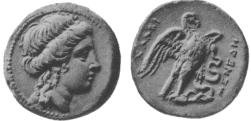
| Female head, with two long locks at back of neck. | ΧΑΛΚΙ Eagle and serpent. Magis-
trate’s name, ΜΕΝΕΔΗ ... (Fig.
202). AR 84 grs.
|
| Id. [B. M. C., Cent. Gr., Pl. XXI. 3.] | ΧΑΛΚΙ Id. AR Diobol.
|
| Head of Hera, facing, wearing coronet
of pearls and fillet. [Hunter Cat., Pl. XXXIII. 8.] |
„ Prow. Magistrate’s name,
ΣΩΣΙΠΑ. AR Tetrob.
|
| ΧΑΛΚΙ Quadriga. [B. M. C., Cent. Gr., Pl. XXI. 4.] |
Magistrate’s name in wreath. Æ .9
|
| Head of Hera crowned with pearls, or facing on the capital of a column. | ΧΑΛΚΙΔΕΩΝ Eagle and serpent
[Ibid., Pl. XXI. 5]. Æ .7
|
On the Imperial coins a head of Hera, crowned with a head-dress com- posed of three tiers of pearls, and fixed on the top of a column is the most frequent type; but on a coin of Sept. Severus a complete statue of the celestial Hera is seen, accompanied by her name ΗΡΑ. (B. M. C., Cent. Gr., Pl. XXI. 12.) She is seated on a conical stone, and wears a long chiton and peplos, and a lofty head-dress; she holds a phiale and a sceptre. The sacred conical stone also occurs by itself as a reverse type. The magistrates’ names on Imperial coins are L. Livius, L. Rufinus, Tib. Claudius Euthycleides, Mescinius, Cleonicus, &c. (Imhoof, Mon. gr., p. 222.)
Cyme, a town of great antiquity on the eastern coast of Euboea, had fallen into a dependent condition, probably before the close of the sixth century B.C. The coins which may be (though only conjecturally) ascribed to it are didrachms and drachms, in style and fabric correspond- ing with the other Euboean series with the Wheel, the Gorgoneion, &c.
| Horse in plain circle. [Beulé, Mon. d'Athenes, p. 19.] |
Incuse square, diagonally divided.
AR Didr.
|
| Forepart of horse in plain circle. | Id. AR Didr. and Dr.
|
| Hindpart of horse in plain circle. [B. M. C., Cent. Gr., Pl. XXIV. 20.] |
Id. AR Didr. and Dr.
|
The horse, as in Thessaly and Boeotia, may he connected with the cultus of Poseidon Hippios.
There exists also a coin of Phocian types and of the Aeginetic standard which, from its inscription, appears to have been struck at Cyme.
| Bull’s head, facing. (Electrotype in Brit. Mus.) | Female head in incuse square, in three
corners of which Κ Υ Μ AR ½ Dr. (?).
|
Eretria. This city was second only to Chalcis in importance, and may lay claim with reasonable show of probability to the following series of coins :—
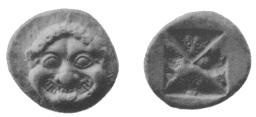
| Bull’s head, facing. [Rev. Num., 1864, Pl. VII. 10.] |
Incuse square. EL ½ Hecte (?).
(Found in Euboea.)
|
| Gorgon-head. | Incuse square, diagonally divided.
AR Didr.
|
| Id. (Fig. 203.) [B. M. C., Cent. Gr., Pl. XXII. 3.] |
Id. Lion’s head, facing, in one angle of
incuse square. AR Didr.
|
| Id. | Id. AR Obol.
|
| Id. [B. M. C., Cent. Gr., Pl. XXII. 7- 10, and Babelon, Traité, Pl. XXXI. 14-17.] | Incuse square, within which, lion’s head,
facing; sometimes between.
AR Tetradr.
|
Unless the two pellets on these coins are meaningless, which is very improbable, they must be marks of value indicating that the so-called tetradrachms of circ. 266 grs. were in the sixth century didrachms and not tetradrachms. This appears to have been also the case at Athens before the reduction by half in the weight of the Attic silver unit of account effected by Hippias. See infra under Athens. Cf. also the silver coins of Etruria (p. 13 sq., supra), where a corresponding change in the nomen- clature of the denominations is noticeable.
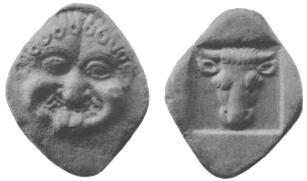
| Gorgon-head (Fig. 204). | Incuse square, within which Bull’s head,
facing. AR Tetradr.
|
| Bull’s head, facing. [Brit. Mus. Guide, Pl. V. 23.] |
Id., diagonally divided. AR Didr.
|
The Gorgoneion and Bull’s head may be symbols of the worship of Artemis Amarysia, a Moon-goddess (?) whose sanctuary near Eretria remained, down to a late date, a kind of Amphictyonic centre for all central and southern Euboea.
The new issue of Eretrian coins, which probably begins about B.C. 511
(Babelon, Traité, p. 685), is marked by a change of fabric. From this
time the pieces are thinner, flatter, and more spread, and are distinguished
by the letters ![]() or
or ![]() R (B. M. C., Cent. Gr., Pl. XXIII. 1-6). This series
probably came to an end in B.C. 490, when Eretria was destroyed and
its inhabitants sold into slavery by the Persian generals Datis and
Artaphernes. The city was, however, shortly afterwards restored, for it
took part in the battles of Artemisium, Salamis, and Plataea.
R (B. M. C., Cent. Gr., Pl. XXIII. 1-6). This series
probably came to an end in B.C. 490, when Eretria was destroyed and
its inhabitants sold into slavery by the Persian generals Datis and
Artaphernes. The city was, however, shortly afterwards restored, for it
took part in the battles of Artemisium, Salamis, and Plataea.
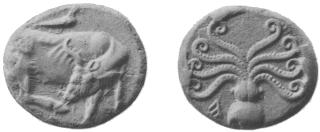
| Cow scratching herself; on her back a swallow. | Octopus in incuse square. AR Tetradr.
(Fig. 205.)
|
| Id.; no swallow. | Id. AR Didr.
|
| Id. | Id. AR Dr.
|
| Head of bull or cow, facing. | Id. AR Diob., Obol, and ½ Obol.
|
| Gorgon-head. [B. M. C., Cent. Gr., Pl. XXIII. 8.] |
Forepart of horse springing from rock,
in incuse square. AR Obol.
|
The octopus or cuttle-fish (τευφις) was the well-known and recognized device or παρασημον of the town of Eretria, just as the owl was of Athens; for Themistocles, on one occasion, mockingly compared the Eretrians to cuttle-fish: τους δε ‘Ερετριεις επισκοπτον ελεγεν οσπερ τευφιδας μαχαιραν μεν εχειν καρδιαν δε μη εχειν (Plut. Apophth. Reg. et Imp. (Themist.), xiv; also Vita Themist., xi).
With the revolt and reconquest of Euboea by Athens in B.C. 445, the right of coinage appears to have been withdrawn from all the cities of the island, but when Euboea regained its autonomy in B.C. 411 it would seem that Eretria became the place of mintage of a series of federal coins then issued with the inscr. ΕΥΒΟΙ, ΕΥΒ, ΕΥ, &c., though with Eretrian types; and (doubtless under Peloponnesian influence) for a brief period according to the Aeginetic standard, as the following coins testify :—
| Incuse square within which ΕVΒ Head
of nymph, Euboea (?) r., hair rolled. [Imhoof, Gr. M., Pl. I. 19.] |
Bull recumbent l., head turned back.
AR Æginetic Stater 184 grs.
|
| Head of nymph, hair rolled, round ear- ring. [N. C., 1892, Pl. XV. 12.] | Incuse square; ΕΥΒ Bull recumbent r.;
above, grapes.
AR Æginetic Stater 182.6 grs.
|
The Aeginetic standard, however, took no firm root in Euboea, and from about B.C. 378, when Eretria again joined the Athenian alliance, the coins once more follow the Euboïc-Attic weights.
| Head of nymph, Euboea (?), hair rolled. [N. C., 1902, Pl. XV. 10; Imhoof, Gr. M., Pl. I. 20.] |
ΕΥΒ Bull standing.
AR Euboïc-Attic Tetradr.
|
| Id. | ΕΥΒΟΙ Id. [Photiades Cat., Pl. III.
452]. AR Euboïc-Attic Tetradr.
|
| Id. [B. M. C., Cent. Gr., Pl. XVII. 1-4.] | ΕΥΒ or ΕΥΒΟΙ Head and neck of bull.
AR Euboïc-Attic Dr. and ½ Dr.
|
| Similar. [Imhoof, Mon. gr., 224.] | ΕΥ or ΕΥΒ Head and neck of bull.
AR Obol.
|
| Similar. [Ibid.] | ΕΥ Bull’s foot. AR ½ Obol.
|
| Similar head, behind, Ε. [B. M. C., Cent. Gr., Pl. XVII. 9, 10.] |
ΕΥΒ Vine branch with two bunches of
grapes. AR Diobol.
|
There are also small bronze coins with Eretrian types, Bull’s head. Rev. Sepia; Bull standing, Rev. Grapes; Head of Nymph, Rev. Bull's head. Inscr., ΕΥΒ, ΕΥΒΟ, &c., which belong to this period (B. M. C., Cent. Gr., Pl. XVII. 11-14).
In the Macedonian period there are no Eretrian coins, but after the liberation of Greece by Flamininus, they again became plentiful. Those of silver were struck in the name of Eretria, but the bronze coins usually, but not always, with the inscr. ΕΥΒΟΙΕΩΝ.
| Bust of Artemis, with bow and quiver at her shoulder. | ΕRΕΤΡΙΕΩΝ Ox standing. Magis-
strates’ names, ΔΑΜΑΣΙΑΣ [Ber-
lin], ΧΑΡΙΔΑΜΟΣ[B. M. C., Cent.
Gr., p. lxv]. The whole in laurel
wreath. AR Tetradr.
|
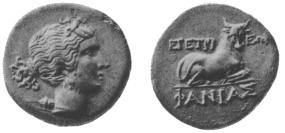
| Head of Artemis (Fig. 206). | ΕΡΕΤΡΙΕΩΝ Ox recumbent.
AR Octobols.
|
| Head of nymph. [B. M. C., Cent. Gr., Pl. XXIII. 11.] |
„ Vine-branch AR Tetrob.
|
| Id. [Ibid., Pl. XXIII. 12.] | „ Head and neck of bull.
AR Triob.
|
All these denominations bear a magistrate’s name in nom. case.
| Veiled female head. [Ibid., Pl. XXIII. 13.] |
ΕΡΕΤΡΙΕΩΝ Ox recumbent. Magis-
trate’s name. Æ .65
|
| Bull standing or recumbent, and star. [B. M. C., Cent. Gr., Pl. XVII. 15, 16.] |
ΕΥΒΟΙΕΩΝ Vine-branch with two
bunches of grapes and star.
Æ .85-.65
|
| Veiled female head. [Ibid., Pl. XVII. 17.] |
„ Bull butting. Æ .6
|
| Id., facing. [Ibid., Pl. XVII. 18.] | „ Prow. Æ .6
|
| Head of Hermes. [Ibid., Pl. XVII. 19.] |
„ Ear of corn. Æ .45
|
Among the Imperial coins of Eretria the only one which calls for remark is a coin of Commodus (N. C., 1902, p. 322), on the reverse of which is ΕΡΕΤΡΙΩΝ and a bust presenting three faces, that in the middle beardless and surmounted by a modius, the others, right and left, male bearded profiles. This coin is suggestive of the cultus of the Kabeiri, but see H. v. Fritze, Z. f. N., xxiv. 125.
Histiaea. The first coins which can be with certainty attributed to Histiaea belong to the half-century before Alexander. It’s interesting to note that the vines which had obtained for the town, as early as Homer’s days, the epithet πολυσταφυλος occupy an important place on the coins. (R. Weil, Z. f. N., i. 183.)
| Head of Maenad, wearing vine-wreath. [B. M. C., Cent. Gr., Pl. XXIV. 1.] |
ΙΣΤΙ Bull, standing before a vine with
grapes; symbol or monogram in
field. AR Dr.
|
| Id. [Ibid., Pl. XXIV. 3-5.] | ΙΣΤΙ Bull, forepart of bull, or bull's
head and neck; various symbols
above. Æ .6
|
The next issue of Histiaean coins probably took place after the Euboean towns declared themselves independent in B.C. 313, but it does not seem to have been of long duration.
| Head of Maenad, with vine-wreath; her hair in sphendone. [Zeit. f. Num., i. p. 186; Photiades Cat., 484.] | ΙΣΤΙΑΙΕΩΝ Nymph Histiaea with her
name ΙΣΤΙΑΙΑ, seated on stern of
galley and holding a trophy-stand or
mast with yard (?) AR Octobol 89 grs.
|
| Id. [B. M. C., Cent. Gr., Pl. XXIV. 6.] | Id., without name of nymph.
AR Tetrob. 42 grs.
|
| Id. [Hunter Cat., Pl. XXXIII. 14.] | ΙΣΤΙ Bull standing; behind, vine. Æ .75
|
| Id. [Ibid., Pl. XXIV. 8.] | „ Bull’s head and neck. Æ .65
|
| Head of Dionysos, facing. | „ Vine-branch. Æ .55
|
The silver coins of this time are remarkably abundant, and consist of tetrobols similar in type to those of the previous century, but very carelessly executed and varying in weight from 39 to 28 grs. The head of the Maenad is almost identical with that on contemporaneous tetrobols of Macedonia, struck between B.C. 185 and 168 during the reigns of Philip V and Perseus. In the Inventory of Demares, compiled B.C. 185-180 (Bull. Corr. Hell., 1882, p. 35), these coins are called Ιστιαικα and αργυριον Ιστιαικον. For varieties see B. M. C., Cent. Gr., Pl. XXIV. The commonest bronze coins of this period are the following :—
| Head of Maenad. | ΙΣΤΙ Head and neck of bull, horns
filleted. Æ .55
|
| Similar. [B. M. C., Cent. Gr., Pl. XXIV. 15, 16.] | ΙΣΤΙΑΙΕΩΝ Grapes. Æ .65
|
| Head of Apollo (?). | „ Tripod. Æ .45
|
Uncertain Coins of Euboïc weight. Sixth century B.C.
| Scarabaeus. [Babelon, Traité, p. 719.] |
Incuse square diagonally divided
AR Didrachm and Obol.
|
| Id. [Imhoof and Keller, Tier- und Pflanzenbilder, Pl. VII. 13.] | Id. AR Obol.
|
| Id. [Ibid., Pl. VII. 14.] | Gorgoneion. AR Size .4 Diob. (?)
|
| Frog swimming. [Babelon, Traité, Pl. XXXIII. 21, 22.] | Incuse square diagonally divided.
AR Obol.
|
| Amphora in plain circle. [Brit. Mus. Guide, Pl. V. 22.] |
Id. AR Didr. 128 grs.
|
| Triskeles in plain circle. [N. C., 1888, Pl. V. 1, 2.] |
Id. AR Didr. 125 grs., Dr., and ½ Dr.
|
| Astragalos in plain circle. [N. C., 1903, Pl. X. 6.] |
Id. AR Didr. 130 grs.
|
These coins belong to the same class as those with the Wheel, attributed to Chalcis, the Gorgoneion to Eretria, and the Horse to Cyme, &c.